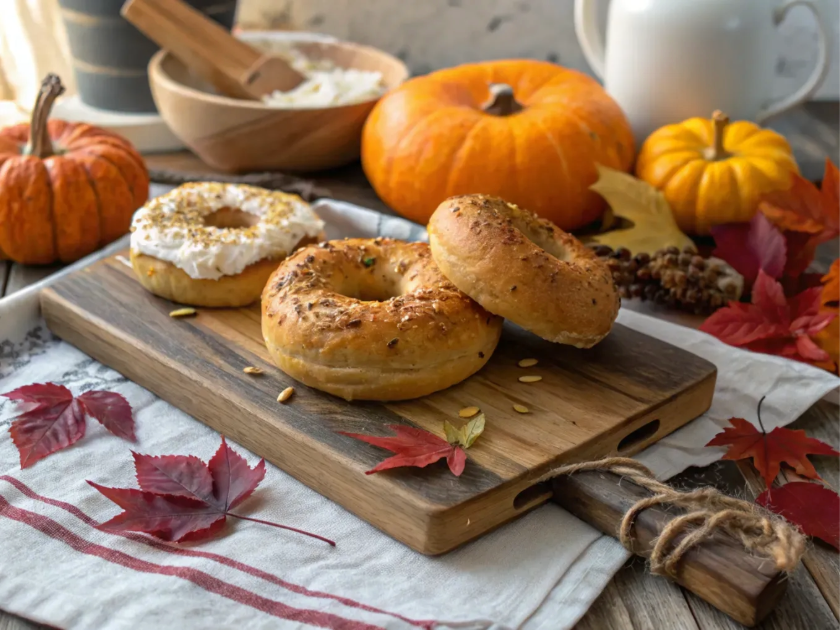Are pumpkin bagels good for you? These seasonal treats are especially popular in the fall, offering a chewy texture and warm, sweet flavor that makes them a favorite. But how do they fit into a healthy diet? This article explores their nutritional value, benefits, and how they compare to other bagels. Let’s find out if pumpkin bagels are a smart choice for your breakfast.
Table of contents
What Makes Pumpkin Bagels Unique?
Pumpkin bagels are special because of their unique flavor and ingredients. They are made with pumpkin puree, which adds both taste and nutrients. Warm spices like cinnamon and nutmeg enhance their flavor. These bagels are a perfect mix of sweet and savory.
Ingredients Breakdown
The ingredients in pumpkin bagel impact their flavor and health benefits. Here is a simple table showing the typical ingredients and their roles:
| Ingredient | Amount | Notes |
|---|---|---|
| Pumpkin Puree | 1 cup | Adds fiber and vitamin A |
| Whole Wheat Flour | 2 cups | Healthier than white flour |
| Brown Sugar | 3 tbsp | Adds sweetness, can be reduced |
| Yeast | 1 packet | Helps dough rise |
| Spices (Cinnamon, Nutmeg) | 2 tsp | Adds warm, seasonal flavor |
| Salt | 1 tsp | Balances flavors |
| Water | 1 cup | Moistens the dough |
Pumpkin puree adds vitamins and fiber. Using whole wheat flour boosts the bagels’ fiber content, making them more filling and nutritious. However, sugar content can vary depending on the recipe.
Are Pumpkin Bagels Good for You? Understanding Their Nutritional Value
Pumpkin bagels can be a healthy option depending on how they are made. Here’s a basic nutritional breakdown:
- Calories: About 250-300 per bagel, based on size and ingredients.
- Carbohydrates: Around 50 grams, providing quick energy.
- Protein: 6-8 grams, supporting muscle health.
- Fat: Less than 2 grams, with minimal saturated fat.
These bagels are rich in carbs, making them a good energy source. The pumpkin adds nutrients like vitamin A and antioxidants. If made with whole wheat flour, they also provide more fiber than regular bagels.
Health Benefits of Pumpkin Bagels
Packed with Nutrients
Pumpkin serves as the main ingredient, and accordingly, it makes the bagel nutritious. Additionally, it contains beta-carotene, which is an antioxidant that, consequently, converts into vitamin A in the body. Specifically, vitamin A supports eye health, boosts immunity, and promotes healthy skin. Moreover, pumpkin remains low in calories but, at the same time, offers high fiber content, which significantly aids digestion.
More Fiber for Better Digestion
Whole wheat flour adds extra fiber, which supports digestion and keeps you feeling full longer. Fiber also helps control blood sugar levels and promotes heart health.
Want to try making them yourself? Check out our Pumpkin Bagels Recipe.
How Do Pumpkin Bagels Compare to Other Varieties?
Pumpkin bagels stand out from other types of bagels. Here’s how they compare:
- Plain Bagels: These are simple and lower in sugar. However, they lack the added fiber and vitamins from pumpkin.
- Everything Bagels: These are savory and flavorful but often high in sodium. They do not offer the antioxidants found in pumpkin bagels.
- Pumpkin Bagels: A balanced option, combining sweetness with added nutrients and antioxidants.
Pumpkin bagels are a healthier choice if you want extra nutrients without extra salt. They are especially good for fall breakfasts.

Wondering about other bagels? Learn more about Are Blueberry Bagels Healthy?.
Tips for Making Healthier Pumpkin Bagels
Whether you buy or bake them, there are ways to make pumpkin bagels healthier:
- Choose Whole Wheat Flour: This adds fiber and keeps you full longer. It also supports healthy digestion.
- Reduce Sugar: Use less sugar in the dough. You can replace it with honey or maple syrup for natural sweetness.
- Add Seeds: Mix in chia or flaxseeds to boost fiber and omega-3 fatty acids.
- Pick Healthy Toppings: Use options like almond butter, avocado, or low-fat cream cheese. Avoid sugary spreads.
Are Bagels Good for You?
Bagels are delicious, but they often have a reputation for being unhealthy. Let’s look at the pros and cons.
The Good Side of Bagels
- Energy Boost: Bagels are rich in carbs, giving you quick energy.
- Customizable: You can top them with a variety of healthy options.
- Comfort Food: Bagels are filling and satisfying.
The Downsides
- High Calories: Some bagels, especially large ones, can be very calorie-dense.
- Low Fiber (Traditional Recipes): Bagels made with refined flour may not keep you full for long.
- High Sodium: Flavored bagels like everything bagels can contain a lot of salt.
Pumpkin bagels, especially homemade ones, can be a healthier choice. They provide added nutrients while offering the same satisfying texture.

Pro Tips and Variations
Pumpkin bagels are versatile, and with some creativity, you can elevate their flavor and nutrition. Whether you’re a seasoned baker or just starting out, these tips and variations will inspire you to experiment and make them unique.
Pro Tips for Perfect Pumpkin Bagels
- Use Fresh Pumpkin Puree: Freshly made pumpkin puree often has a richer flavor and better texture than canned versions. Roast a pumpkin, scoop out the flesh, and blend it until smooth for the best results.
- Proof the Dough Correctly: Always allow the dough to rise in a warm, draft-free place. An under-proofed dough can result in dense bagels, while over-proofing may cause them to lose their shape during baking.
- Boil with a Touch of Sweetener: Adding a tablespoon of honey or sugar to the boiling water enhances the bagel’s golden crust and subtle sweetness.
- Keep Dough Hydrated: Pumpkin puree adds moisture, but if the dough feels dry, add a teaspoon of water at a time until it’s smooth and pliable.
For step-by-step instructions on creating delicious pumpkin bagels at home, visit our Pumpkin Bagels Recipe.
Creative Variations to Try
- Sweet Pumpkin Bagels: Add a teaspoon of vanilla extract to the dough and mix in dried cranberries or raisins. Top with cinnamon sugar before baking for a dessert-like twist.
- Savory Pumpkin Bagels: Incorporate shredded cheddar cheese and a pinch of garlic powder into the dough. Sprinkle with pumpkin seeds or sesame seeds for a crunchy topping.
- Stuffed Pumpkin Bagels: Before shaping the dough into rings, fill each portion with cream cheese or spiced pumpkin butter. Seal the edges tightly to avoid leaks during boiling and baking.
- Gluten-Free Pumpkin Bagels: Use a high-quality gluten-free flour blend and add a teaspoon of xanthan gum to mimic the elasticity of regular dough. Adjust water as needed to maintain the dough’s consistency.
By tweaking the ingredients and preparation methods, you can create a version of pumpkin bagel that perfectly suits your preferences.

FAQs: Your Questions Answered
Pumpkin bagels are a trending choice, but you might still have questions about their nutritional value and health benefits. Below are answers to common questions to help you make informed decisions.
Is bagels good for you or bad for you?
Bagels can be both, depending on how they’re made and eaten. Traditional bagels made with refined flour are low in fiber and can cause quick spikes in blood sugar. However, whole-grain varieties made with whole wheat flour provide more fiber and essential nutrients. Toppings also matter—choose nutrient-dense options like avocado, hummus, or almond butter for a healthier meal.
What is the nutritional value of a pumpkin bagel?
A standard pumpkin bagel offers around 250–300 calories, depending on its size and ingredients. It typically contains:
- Carbohydrates: 50 grams, providing energy.
- Protein: 6–8 grams, supporting muscle health and satiety.
- Fiber: 3–4 grams, aiding digestion and blood sugar regulation.
- Vitamin A: Pumpkin puree is rich in beta-carotene, which promotes vision and immune health.
For more information about other nutritious bagel options, read our guide on Are Blueberry Bagels Healthy?.
Are pumpkins good for you?
Yes, pumpkins are incredibly healthy. They are low in calories but packed with essential nutrients. Their high beta-carotene content supports vision and boosts immunity. Additionally, pumpkins provide dietary fiber, which aids digestion and helps manage weight. They also contain potassium, which promotes heart health and regulates blood pressure.
Are everything bagels good for you?
Everything bagels are flavorful and versatile, but they can be high in sodium. While they lack the added nutrients found in pumpkin bagels, they can still be part of a healthy diet if consumed in moderation. Opt for whole-grain versions and pair them with nutrient-rich toppings like low-fat cream cheese or smoked salmon.
Can I freeze pumpkin bagels?
Yes, freezing pumpkin bagels is a great way to preserve them. Allow the bagels to cool completely after baking. Place them in an airtight container or freezer bag. To enjoy, thaw them at room temperature and reheat in the oven or toaster for a fresh taste.
How can I serve pumpkin bagels creatively?
There are endless possibilities for serving pumpkin bagels. For a sweet option, spread cream cheese, drizzle with honey, and sprinkle with crushed walnuts. For savory flavors, top with smashed avocado, a fried egg, and a dash of chili flakes.
What’s the best way to make pumpkin bagels healthier?
To make healthier pumpkin bagels, use whole wheat flour and reduce the sugar in the dough. Mix in seeds like flax or chia for added fiber and omega-3 fatty acids. When it comes to toppings, opt for low-fat spreads or fresh fruit.

Health Benefits of Pumpkin Bagels
Pumpkin bagels are not just a treat for your taste buds—they also offer numerous health benefits. Here’s why they’re worth adding to your menu:
- Rich in Nutrients: Pumpkin puree provides beta-carotene, which converts to vitamin A in the body. This vitamin supports vision, immunity, and skin health. Whole wheat flour adds B vitamins, magnesium, and fiber.
- Supports Digestion: The fiber in pumpkin and whole wheat flour helps regulate digestion and promotes gut health. This makes pumpkin bagels a more filling option compared to traditional ones.
- Boosts Energy Levels: With 50 grams of carbohydrates per serving, pumpkin bagels are a great source of quick energy. They’re ideal for breakfast or as a pre-workout snack.
- Low in Saturated Fats: When made with simple ingredients, pumpkin bagels are naturally low in unhealthy fats. Adding nutrient-rich toppings further enhances their health benefits.
These benefits make pumpkin bagels a balanced choice for those looking for a nutritious yet indulgent option.

Conclusion
Pumpkin bagels offer a delightful blend of flavor and nutrition, making them a versatile choice. Additionally, they provide essential vitamins, fiber, and carbohydrates, which help fuel your day. According to the U.S. Department of Agriculture (USDA), pumpkin is rich in nutrients like vitamin A, potassium, and antioxidants, contributing to overall health benefits. Whether you prefer them sweet or savory, they can be customized to suit your preferences and dietary needs. By using wholesome ingredients and mindful toppings, you can transform these seasonal favorites into a healthy staple.
So, are they good for you? Absolutely—when made thoughtfully, they are as nutritious as they are delicious.

